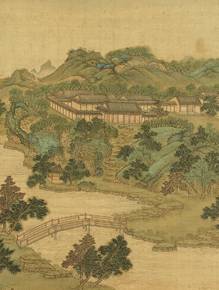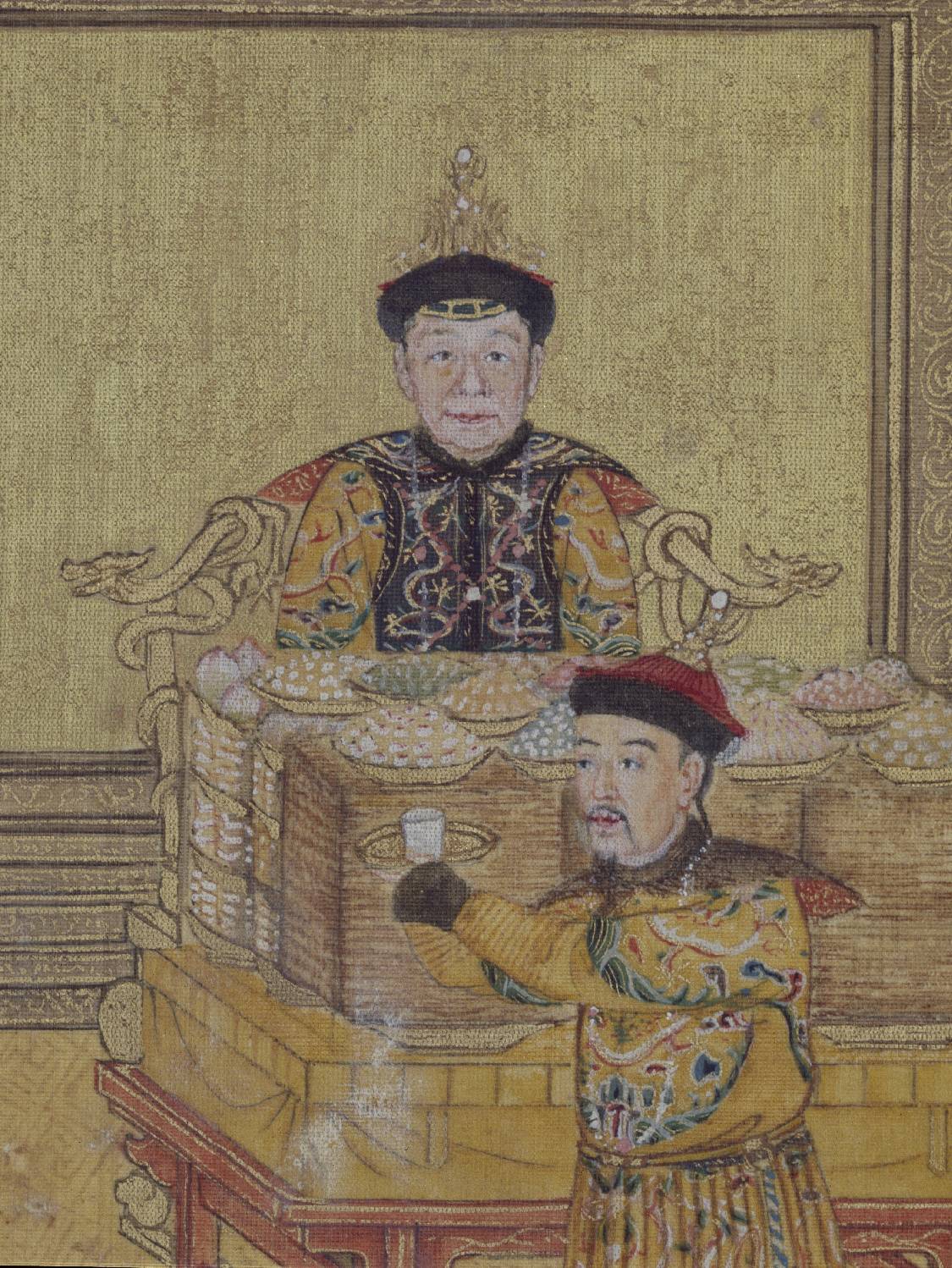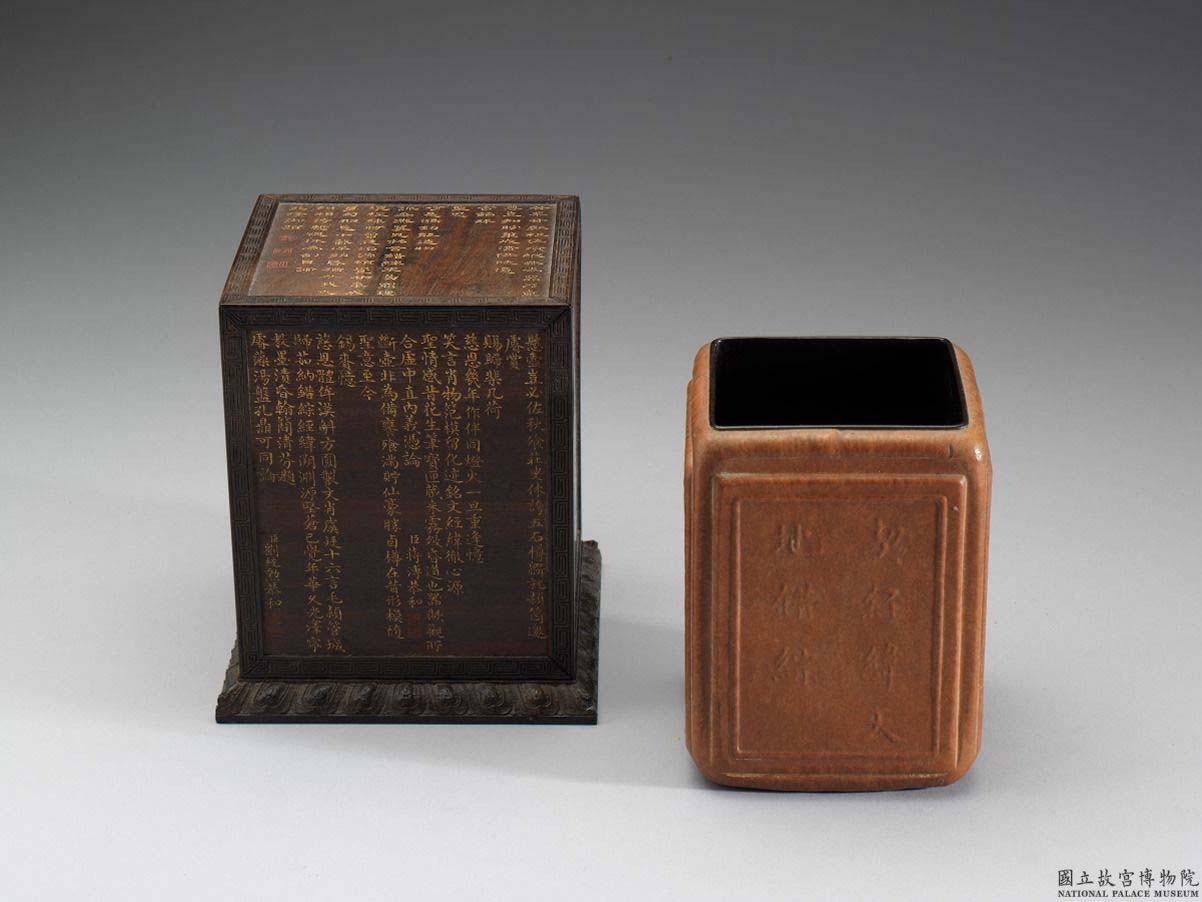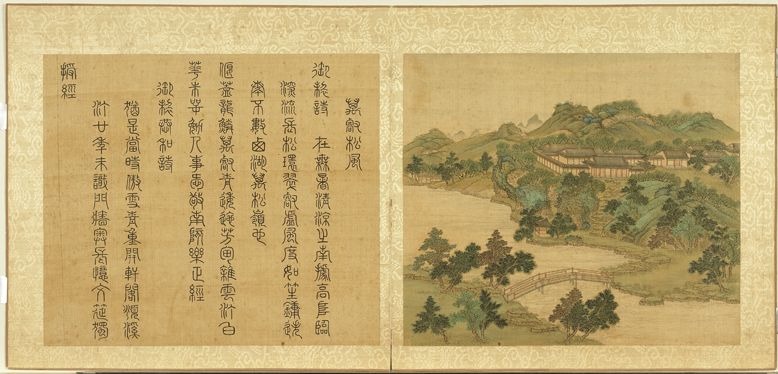Young and Old
Great Affection and Filial Piety
The emperors of the Forbidden City had many sons, but they did not necessarily share equally close relationships. In the imperial family, is it possible to not be hindered by rites and rituals and show filial piety out of genuine sentiment? The love shared between the Kangxi Emperor and the young Prince Hongli (later the Qianlong Emperor) as grandfather and grandson, and the love shared between the Empress Dowager Chongqing and the Qianlong Emperor as mother and son are both exemplary of affection and filial piety highly regarded and respected by later generations.

The Kangxi Emperor
and
The Qianlong Emperor
The Empress Dowager Chongqing
and
The Qianlong Emperor

The Kangxi Emperor
and
The Qianlong Emperor
The Kangxi Emperor (1654-1772) had 97 grandchildren and Prince Hongli (1711-1799) was his favourite. In the sixtieth-first year of Kangxi (1722), the Kangxi Emperor met the 12-year-old Hongli for the first time and immediately took to him. From then on, he often kept Hongli by his side, bringing him along on his inspection tours and tutoring him in his studies and martial arts. Besides showering him with care and affection, Kangxi's recognition and trust in Hongli were also evident in his entrusting the country to the latter. Although the time he spent with his grandfather was brief, Hongli missed him dearly after ascending the throne and becoming the Qianlong Emperor. From the following cultural relics, we know that he seemed to miss his grandfather often: when hunting bears, when studying, or when taking his summer retreat… his sense of loss is poignantly touching.

The Qianlong Emperor on a bear hunt, Qianlong period, Qing Dynasty
Provided by the Palace Museum
Commissioned by the Qianlong Emperor, this painting of a hunting scene by Giuseppe Castiglione (1688-1766) et al depicts the Qianlong Emperor in his thirties, drawing attention to his disposition as an emperor as he confronts a black bear.
It is said that when Prince Hongli first accompanied his grandfather on a hunt at the imperial hunting grounds at Mulan, the Kangxi Emperor shot down a black bear and told him to finish it off so that he could gain a reputation for killing a bear on his first hunt. However, the bear suddenly got up and almost pounced on Hongli. The Kangxi Emperor shot down the bear just in time and, in a clear display of affection, said to the young prince, "Your life is precious!" *
Later, Hongli asked to join his uncles on an excursion to hunt tigers but was stopped by his grandfather, who would only feel reassured if he accompanied him: "You cannot go, wait until the day I go, and I will bring you with me," * he said.
*Dong Gao (1810), Huang Qing Wen Ying Xu Bian.


Embossed gourd brush holder, Kangxi period, Qing Dynasty
From the collection of the National Palace Museum, Taipei
This brush holder (right) was a gift from the Kangxi Emperor to Hongli, his grandson and the future Qianlong Emperor. Years later, the brush holder still reminded Qianlong poignantly of his revered grandfather, underscoring the special bond between them. He made a special wood box (left) to contain the brush holder and inscribed his poem on the box.


Antler armchair, Qianlong period, Qing Dynasty
Provided by the Palace Museum
The Qianlong Emperor had this armchair made from the antlers of deer hunted by his grandfather, for whom he had the utmost respect. The poem engraved on the splat, composed by Qianlong, reminisced about his grandfather's remarkable might, and questioned his audacity in sitting on such an extraordinary seat. It was as if Qianlong had cast himself back to his younger days, filled with admiration for the majesty of his imperial grandfather.


Pine Winds through Myriad Vales from the Summer Resort painting scroll, with an album of poems inscribed by the Qianlong Emperor, Qianlong period, Qing Dynasty
From the collection of the National Palace Museum, Taipei
At 12, Prince Hongli spent the hot summer months with the Kangxi Emperor at the Summer Resort, at the compound known as "Pine Winds through Myriad Vales". One day, Kangxi sailed out into the lake. Hongli was playing on a hill, and when he spotted the imperial boat coming from the distance, he ran down the hill in joy. Seeing this and worried that his grandson would fall, Kangxi hurried to the front of the boat and called out loudly at him, "Slow down, don't fall!"
His grandfather's anxious voice made a deep impression on Hongli, and he even recalled the incident 60 years later in his poem Recollections of Clear Jade Pavilion: "On the shady side of the hill at Pine Winds through Myriad Vales, a pavilion named Clear Jade stands next to the stream. When I was 12 years of age, I came here with my grandfather and was immediately bestowed a place of residence next to the hall. Upon seeing the imperial boat coming to moor by the pavilion, I called for my grandfather and hurried down the steep slope. He turned around and said, 'Haste not, lest you fall'. Nevertheless, this was the day when I was first graced with his favour."
This painting, by Zhang Ruoai (1713-1746), depicts the scenes of the Summer Resort, in every page of which is inscribed with Qianlong Emperor's and his grandfather's poems.


Celadon jade seal with entwined dragon knob and "The Hall of Grace Remembrance" inscription, Qianlong period, Qing Dynasty
Provided by the Palace Museum
After Prince Hongli acceded to the throne, he named two buildings' The Hall of Grace Remembrance' to commemorate the grace that was bestowed upon him by his grandfather: one, Pine Winds through Myriad Vales at the Summer Resort; the other, a building on the Peony Terrace in the Garden of Perfect Brightness.


The Empress Dowager Chongqing
and
The Qianlong Emperor
Lady Niohuru (1693-1777), the Qianlong Emperor's birth mother, entered the residence of Prince Yong of the First Rank as a concubine at the age of 13. The Yongzheng Emperor (1678-1735) later promoted her to the rank of Noble Consort. After he acceded to the throne, the Qianlong Emperor honoured her as Empress Dowager Chongqing. He spared no effort looking after her every need, whether it be enquiring about her well-being, taking her on excursions, or presenting her with birthday gifts and arranging her funeral. Rather than attributing his actions to a desire to go down in history as a sage ruler, let us try to understand how the Qianlong Emperor's love for his mother mirrors his filial piety through the stories behind the treasures.

Interior of the back hall of the Palace of Longevity and Health
Provided by the Palace Museum
After his accession to the throne, the Qianlong Emperor ordered the construction of the Palace of Longevity and Health as the residence for his mother. He named the palace to bless her with long life and good health. On an auspicious day in the eleventh month of the lunar year in the first year of Qianlong (1736), Empress Dowager Chongqing moved into the palace, where she lived for 42 years until her death.
The Palace of Longevity and Health contains many of Qianlong Emperor's treasures to his mother, such as a hardwood imperial lantern with glass inlays, Red sandalwood bamboo-style throne inlaid with precious stones, etc. It was said that more than 40 poems and inscriptions by Qianlong were displayed in the Palace at the time of the Empress Dowager Chongqing’s death. The palace inventory had a large collection of artifacts, including 623 jadeite objects, 1,592 ruyi sceptres, as well as 119 items of calligraphy and books.


Hardwood imperial lantern with glass inlays, Qing Dynasty
Provided by the Palace Museum
This beautiful palace lantern is one of the treasures displayed in its original state at the Palace of Longevity and Health.
The upper section showcases a vigorous, luxurious and auspicious scene in the form of a miniature landscape of plum blossoms, chrysanthemums, hibiscuses, sacred lilies and camellias made from jade, coral, ivory and crystal.
The lower section is a hexagonal red sandalwood frame with jade inlays. The auspicious gourd and bat motifs on the frame symbolise good fortune and longevity.


Red sandalwood bamboo-style throne inlaid with precious stones, Qianlong period, Qing Dynasty
Provided by the Palace Museum
The inside and outside of the throne are exquisitely decorated with floral designs inlaid with precious stones; the seat is painted with black lacquer and decorated with gilt western-style floral designs and cloud and bat motifs. The edges of the seat are inlaid with carved jade plaques showing dragons soaring through flowers.





Fan with painting and poem by the emperor, Qianlong period, Qing Dynasty
Provided by the Palace Museum
Whether seasonal produce from the imperial orchards, tributes of citrons and lychees from the South, or game from the Mulan imperial hunt, the Qianlong Emperor would always offer them to the Empress Dowager in the first instance.
Moreover, while the Empress Dowager was alive, Qianlong would almost always have her accompany him on the excursion, taking pleasure in having his mother travel with him.
Qianlong painted this fan for the Empress Dowager after they enjoyed viewing lotus blossoms together in the imperial garden.



Folding fan with painting and poem by the emperor, Qianlong period, Qing Dynasty
Provided by the Palace Museum
The Qianlong Emperor frequently spent time with his mother. He would take her with him to the Chengde Mountain Resort in the summer, as well as on his longer excursions to Shandong, Jiangnan and Wutaishan.
On his third excursion south with his mother in the 27th year of his reign (1762), Qianlong had to leave her for half a month, travelling separately overland to inspect a water conservancy project. When mother and son reunited at Dezhou later, Qianlong immediately enquired after her wellbeing and presented her with a folding fan he had prepared while they were apart.
On one side of the fan, Qianlong painted a daylily plant and an amorphous rock. On the other side he wrote a poem conveying his concern as to whether his mother had been sleeping and eating well during his absence, and his relief on seeing her again.



Agarwood root carving of a deer, Qing Dynasty
Provided by the Palace Museum
The Qianlong Emperor was assiduous in celebrating the birthdays of the Empress Dowager Chongqing, leading his family, clan members and ministers in presenting gifts of ruyi sceptres, statues of the Buddha, Buddhist scriptures, paintings and calligraphy, and all kinds of beautiful artifacts. Showcasing exquisite craftsmanship and a graceful form, this root carving was a gift presented to the empress dowager for her eightieth birthday.


Gilt cup and saucer with embossed design and pearl inlays, Qing Dynasty
Provided by the Palace Museum
This set of cup and saucer is from the collection of the Palace of Longevity and Health. The lugs of the cup feature four characters in seal script, carved in openwork, that mean "long life" and "boundless". It was most likely used during the empress dowager’s birthday celebrations.


Coloured peaches on carmine enamel platter, Qing Dynasty
Provided by the Palace Museum
This is a gift for the Empress Dowager Chongqing on her sixtieth birthday. The item's name as shown on the list of gifts is "Large bonsai of Suishan peaches of eternal bliss, carved from ivory" *.
The large carmine enamel plate is loaded with layers of peaches made of ivory. The peaches are hollow in the middle, with stems shaped like screws and attached to a branch carved in the round on the plate. The leaves are similarly screwed onto the branch. The carving and colouring are vivid and lifelike.
*Zhao Yi (Qing Dynasty), Yan Bao Za Ji.


Celebration of the birthday of Empress Dowager Chongqing, Qianlong period, Qing Dynasty
Provided by the Palace Museum
The birthday of the Empress Dowager is also known as the “Festival of Imperial Birthday”, where large scale celebrations would be held. The Qianlong Emperor would further instruct painters to record such scenes in paintings.
On the occasion of the sixtieth birthday of his mother, Qianlong arranged for elaborate activities, with festivities and parades all the way from the Gardens of Clear Ripples by the Longevity Hill to the Palace of Peaceful Longevity in the Forbidden City. Zhao Yi (1727-1814), a contemporary, describes the grand occasion he witnessed, “Palaces are lavishly adorned. Colourful silk flowers, tapestry houses, sumptuous lighting, chairs with precious stones – all in rich and vibrant colours that cannot be adequately described in words.” The pomp and pageantry of the celebrations were unparalleled.


Celebrating Empress Dowager Chongqing's Birthday (Detail), Qianlong period, Qing Dynasty
Provided by the Palace Museum
When preparing for the Empress Dowager Chongqing's sixtieth birthday celebrations, officials proposed to build a resplendent boat, but ignored the freezing weather and ordered workers to "work day and night, some to strike the water, others to stir the water to stop it from freezing", which of course did not work.
In the end, the empress dowager entered the city on a boat of ice pulled by men. The proponents had their salaries suspended for a year as punishment.


Joyous Birthday Celebration Scenes: Banquets and Entertainments at the Palace of Benevolence and Tranquillity (Detail), Qianlong period, Qing Dynasty
Provided by the Palace Museum
A birthday party would not be complete without a theatre performance. All the stages in the Forbidden City had special performances of the “Double Nine Grand Operas”, which included auspicious birthday operas such as Presenting Lingzhi to Aid Longevity, Double Happiness of Fortune and Longevity, Five Blessings for Five Generations, Friendship with Three Elders, Fortune, Wealth and Longevity, and Revered by All the Subjects. The atmosphere bustled with excitement.
The culmination of the celebrations was, of course, when the Qianlong Emperor held up a glass of wine and personally offered birthday congratulations to the empress dowager. It is said that he would dance to amuse his mother when he was slightly tipsy.



Gold stūpa containing the Empress Dowager Chongqing's hair, Qianlong period, Qing Dynasty
Provided by the Palace Museum
While preparing for the empress dowager’s ninetieth birthday, the Qianlong Emperor wrote a poem, “I respectfully await your ninetieth birthday, a new painting has been painted”. However, the empress dowager passed away on the twentieth-third day of the first month of the forty-second regnal year of Qianlong (1777).
After her death, Qianlong ordered a gold stūpa to be made to store his mother's fallen locks. He gave his attention to its production and continually issued new instructions. At the time, the gold artefacts in the Garden of Exuberant Spring totalled more than 1,300 taels, but the Qianlong Emperor found the amount lacking, so the gold artifacts in the Palace of Longevity and Health were melted with over 700 taels of silver to obtain a total of 3,900 taels, nine maces and eight candareens of gold with 60% purity. It took almost a year to cast the stūpa, which was inlaid with precious gems such as turquoise and coral. It was enshrined in the East Warmth Chamber at the Palace of Longevity and Health.
Inside the stūpa is a statue of Amitāyus, the Buddha of Infinite Life, clearly revealing the Qianlong Emperor's wish for his mother to ascend to the Western Paradise.








